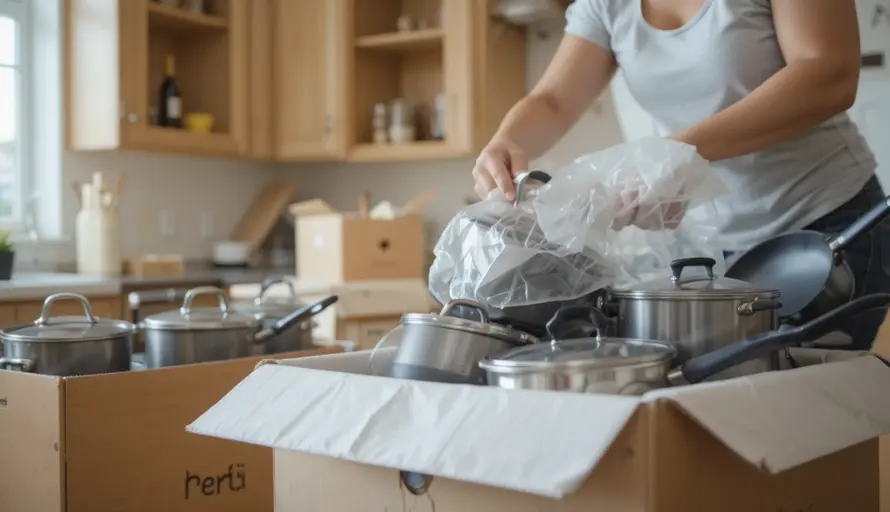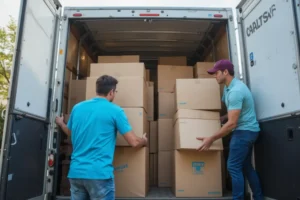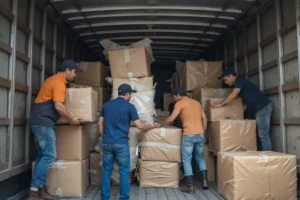Best Way to Pack Kitchen Items Without Breaking Anything

Get Your Free Moving Estimate
Packing your kitchen for moving can feel overwhelming. With so many fragile dishes, appliances, and utensils, it’s easy to make mistakes that lead to broken items or wasted time. Whether you’re relocating across town or cross-country, learning how to pack a kitchen properly can save you money, stress, and mess.
In this guide, we’ll show you the best way to pack kitchen items without breaking anything, using expert tips and efficient packing strategies for a smooth move.
Step 1: Declutter Before You Pack
Before learning how to pack a kitchen for moving, start by decluttering. Go through your drawers, shelves, and pantry. Donate or discard anything you no longer use old utensils, duplicate pots, expired food, or chipped plates.
This simple step will make packing kitchen items easier and reduce moving costs, especially if you’re paying by weight.
Step 2: Gather the Right Packing Supplies
Packing a kitchen requires sturdy materials. Before you pack kitchen for moving, make sure you have:
-
Strong moving boxes (small to medium sizes work best for heavy items)
-
Packing paper or bubble wrap
-
Packing tape
-
Dish dividers or cardboard inserts
-
Labels and markers
Using the right materials is key when figuring out how to pack kitchenware and prevent damage.
Professional Long Distance Movers
Step 3: How to Pack Pots and Pans for Moving
If you’re wondering how do you pack pots and pans for moving, start by nesting them by size. Place a sheet of packing paper or bubble wrap between each one. Lids should be wrapped separately and placed vertically along the box’s edge.
For nonstick pans, use soft paper instead of newspaper to avoid scratching the coating. Label each box clearly as “Kitchen – Pots & Pans.”
Step 4: How to Pack Utensils for Moving
To pack utensils for moving, sort them into groups cooking spoons, forks, knives, and other small tools. Bundle each set with a rubber band, then wrap them in paper or a kitchen towel.
For packing knives, wrap each knife individually with bubble wrap or cardboard around the blade and secure with tape. Always pack them with the blades pointing down for safety.
Step 5: How to Pack Small Kitchen Appliances for Moving
When learning how to pack small kitchen appliances for moving, start by cleaning and drying them thoroughly. Remove detachable parts like blender jars or toaster trays and pack them separately. Use the original boxes if possible; if not, wrap appliances in paper and cushion them with towels.
Fill any empty spaces in the box with paper or foam to prevent shifting during the move.
Step 6: How to Pack Dishes, Glasses, and Bowls
This is where most damage occurs, so it’s crucial to know the best way to pack kitchen items like glassware and dishes.
-
Wrap each plate or bowl individually in packing paper.
-
Stack them vertically (like records) in small boxes.
-
For glasses, use cardboard dividers or wrap them tightly in bubble wrap.
-
Clearly mark the box “Fragile – Kitchen” on all sides.
Step 7: How to Pack Pantry Items and Food
If you’re figuring out how to pack kitchen items for moving, don’t forget your pantry.
-
Seal any open containers tightly.
-
Avoid packing perishable food for long-distance moves.
-
Use small boxes to pack cans, spices, and dry goods.
Group similar items together for easy unpacking.
Step 8: Label Everything Clearly
Once you’ve finished packing kitchen moving boxes, label each one with its contents and destination (e.g., “Plates – Upper Cabinet”). This saves time when unpacking and helps movers handle fragile items carefully.
Pro Tips for How to Pack Kitchen When Moving
-
Keep an “Essentials Box” with daily-use items: coffee maker, two plates, two cups, and basic utensils.
-
Avoid overloading boxes; a lighter box is safer to carry.
-
Take photos of appliance setups before unplugging them.
-
Use towels or oven mitts as extra cushioning material.
Final Thoughts
Knowing how to pack a kitchen the right way can make all the difference in protecting your cookware, dishes, and appliances. With proper planning, materials, and care, you can pack pots and pans, utensils, and small appliances without breaking a thing.
If you’re short on time or want professional help, consider hiring professional movers who specialize in packing kitchen items for moving safely and efficiently.
Frequently Asked Questions (FAQs)
What is the best way to pack kitchen items for a long-distance move?
Use small, sturdy boxes, wrap each fragile item individually, and label boxes as “Fragile.” Avoid mixing heavy and light items in the same box.
How do you pack pots and pans for moving without scratching them?
Nest them by size with paper between each one, and wrap lids separately. Nonstick pans should be wrapped with soft paper or cloth.
How early should I start packing my kitchen before moving?
Start at least 1–2 weeks before moving day. Begin with items you rarely use and save essentials for last.
Can I use newspaper instead of packing paper for kitchen items?
Yes, but avoid direct contact with delicate surfaces or dishes since ink can transfer.



